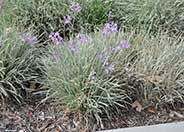
Common name:Silver Lace Society Garlic
Botanical name:Tulbaghia violacea 'Silver Lace'
This evergreen perennial has white-margined, thin strap-like leaves and rosy-lavender-pink flowers that bloom in spring and summer. Foliage has a garlic odor when bruised. Plant in full sun and give moderate amount of water. This plant reaches 1'-3' tall and 1'-2' wide.
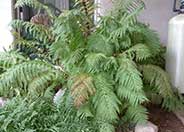
Common name:Giant Chain Fern
Botanical name:Woodwardia fimbriata
The Giant Chain Fern is a large fern that grows 4'-8' tall. It can tolerate full sun but does best in some shade. This fern is native to California and is drought tolerant.
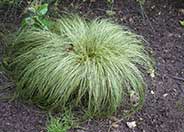
Common name:Frosty Curls Sedge
Botanical name:Carex albula 'Frosty Curls'
Carex 'Frosty Curls' is actually likely C. albula rather than C.comans but is well confused in the nursery industry. 'Frosty Curls' belongs to the group of New Zealand sedges that prefer well drained, drier conditions than other sedges typically
prefer. If planted in inundated conditions, this sedge may struggle significantly. Otherwise, planted in groups or individually, it can be quite spectacular and carefree, providing foliage interest year round with light, almost silver weeping foliage.
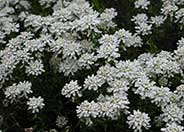
Common name:Evergreen Candytuft
Botanical name:Iberis sempervirens
This Evergreen Candytuft is a compact plant that grows 12"-18" tall. Its leaves are dark green in color; in the early spring, it exhibits clusters of pure white flowers that are borne at branch ends.
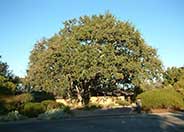
Common name:Coast Live Oak
Botanical name:Quercus agrifolia
Coast Live Oak (Quercus agrifolia) is one of the best trees for California native or California-friendly gardens. It grows very well from the coastal areas to the interior valleys. It is an evergreen tree that can reach 25’-70' tall and up to 70' wide, so make sure you have the space in your garden to support it. It is considered very low-water-use and is susceptible to root rot in gardens that are over-irrigated. Plant it with other California natives or low-water plants and stick to a watering cycle that includes watering during the fall, winter, and spring with no supplemental water in the summer. The tree is a slow grower and has an irregular shape when it is young, so it is important to make minimal pruning cuts to improve the look of the canopy. Over-pruning or hedging can take years to recover from, so consult or hire a licensed arborist when the shaping becomes out of your reach. This tree will eventually become a large shade tree; therefore, the plant selection around it may need to be adjusted as it matures. This tree should be planted at least five feet away from any hardscape areas, 20 feet from structures such as houses and buildings, and not near any powerlines. Shrubs and perennials should be planted about four feet away from this tree. It should be irrigated for about 45 minutes once a week when using most in-line drip irrigation systems.
Designer: Verdant Landscaping
Photographer: GardenSoft
Maintain a two to four inch layer of mulch on the soil surface to reduce weeds, infiltrate rain water, and reduce compaction.
Mulching and adding compost to soil can minimize evaporation and help soil absorb and store water.
Remove irrigation water and fertilizer from areas where you don't want weeds to grow.